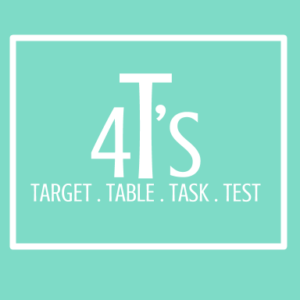What’s the 3rd way you can fix your lesson plans? Create scaffolded student learning opportunities!
Using the Content Break Down discussed in Fix#1, Fix #3 focuses on utilizing scaffolded targets to design meaningful learning opportunities!
The most effective way to create strong, scaffolded targets is to utilize Webb’s Depth Of Knowledge (DOK). DOK allows teachers to build content knowledge in a way that lets learners truly understand content and master material. This assures that they are mastering foundational knowledge before moving on to higher levels of understanding. These targets will further guide your creation of both assessments and learning opportunities.
DOK allows teachers to build content knowledge in a way that lets learners truly understand content and master material. Click To Tweet| DOK Level 1
Recall |
DOK Level 2
Skills/Concepts |
DOK Level 3
Strategic Thinking |
DOK Level 4
Extended Thinking |
| Arrange, Calculate, Cite Define, Describe Draw, Explain, Give examples, Identify Illustrate, Label Locate, List, Match | Apply, Calculate, Categorize, Classify, Compare, Compute, Construct, Convert, Describe, Determine, Distinguish, Estimate, Formulate | Appraise, Assess, Compare, Compile, Conclude, Contrast, Critique, Decide, Defend, Describe, Develop, Differentiate, Distinguish | Appraise, Connect, Create, Critique Design, Judge, Justify, Prove, Report, Synthesize |
| Example : Recall elements and details, conduct basic calculations, or order rational numbers | Example : Sort objects, show relationships, apply a concept, organize, represent and interpret data, or use context clues to identify the meaning of unfamiliar words | Example : Solve non-routine problems, Interpret information from a complex graph, or explain phenomena in terms of concepts | Example : Design and conduct an experiment that requires specifying a problem; report results/solutions or critique experimental designs |
Note: Adapted from “Web Alignment Tool” by Wisconsin Center For Education – The University of Wisconsin-Madison, 2005.
Now, How do you use this process to create valuable learning opportunities?
Plan each learning opportunity using the 4T’s.
Target: Identify a specific Tiered Target and corresponding Mastery Questions
Table: Use the Table of DOK Starters to consider the task you would like your students to complete.
(Example : Recall elements and details, conduct basic calculations, or order rational numbers)
Task: Design a task for students to complete. Each element of the task should directly align to the Target and/or Mastery Question
Test: Conclude your activity with a Quick Check/Formative Check. You should be able to confidently answer this question… “Did they Master the content?”
Keep enhancing your lesson plans with the other 8 fixes within our “9 Ways to Fix Your Lesson Plans” series!
Fix 1 : Align Standards, Targets, and Mastery Questions (Click to Read!)
Fix 2: Personalize Learning (Click to Read!)
Fix 3: Scaffold Student Learning Opportunities (CHECK!)
Fix 4: Ask Your Students (Click to Read!)
Fix 5: Connect Your Content (Click to Read!)
Fix 6: Acquire Classroom Funding (Click to Read!)
Fix 7: Create Differentiated Tools (Click to Read!)
Fix 8: Assess Understanding, not Task Completion (Click to Read!)
Fix 9: Ask your PLN (coming soon!)




